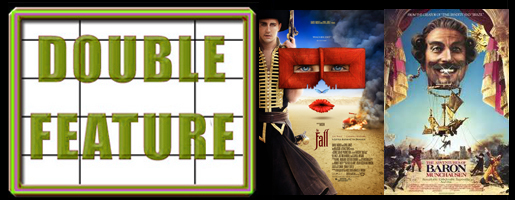
The double feature is cinema appreciation at its most basic. The mere act of pairing two films together – whether the bond be subject matter, central theme, a certain actor or filmmaker, or something outside-the-box conceptual – causes them to take on a different sort of life. A new relationship is formed with the viewer. You pay attention to new aspects and journey down unfamiliar avenues when you view films through Double Feature Goggles. Even when the linking bond is comically tenuous, the double feature magic is there. And I’m the kind of guy who derives just as much pleasure from creating a double feature as I do from watching one. Aside from amusing myself, hopefully I can give some people ideas for their next movie night.
The Double Feature: The Fall (2008) and The Adventures of Baron Munchausen (1988).
The Connection: An uncompromising filmmaker. Astounding visuals. A relationship between a man and a dentally challenged little girl. A super team of fantasy badasses. The power of escapism through storytelling. The precarious balance between fact and fiction and outright lying.
Film 1: Tarsem Singh has had a strange career as a feature filmmaker. After coming up during the heyday of the music video scene – most notably directing the video for REM’s “Losing My Religion” – Tarsem finally took to the big leagues with the heinous 2000 J-Lo anusblast The Cell, which felt like freebasing a never ending Marylin Manson video. Then he disappeared into TV commercials, completely un-missed, only to sneak back into the party through the backdoor in 2008 and quietly leave behind one of the most visually arresting films of the past 20 years (of any years, really), without anyone noticing. I don’t think any of us can be blamed for ignoring The Fall when it first hit theaters (the film only made $3 million globally on it release). The Cell didn’t exactly engender a lot of love — I’ve rewatched it recently, and if anything I liked it even less than I did in 2000. But The Fall is something special.
The film is set in a Los Angeles hospital, in the early 20-century. A little Romanian girl named Alexandria (Catinca Untaru) is staying at the hospital with a broken arm — an injury she received while picking oranges with her poor immigrant family. While meandering the hospital grounds Alexandria meets Roy (Pushing Daisies‘ Lee Pace), a silent film stuntman who broke his back during a dangerous stunt. The two form a friendship, centering on the lavishly epic tale that Roy creates for Alexandria’s entertainment about five brave men – a mute Indian warrior, a muscular African former-slave, an Italian explosives expert, a young Charles Darwin, and a masked bandit – who are on a quest to kill the evil man who individually wronged them all. But the circumstances quickly shift from cute to dark when we realize that Roy has befriended Alexandria so he can manipulate her into stealing him enough morphine to commit suicide.
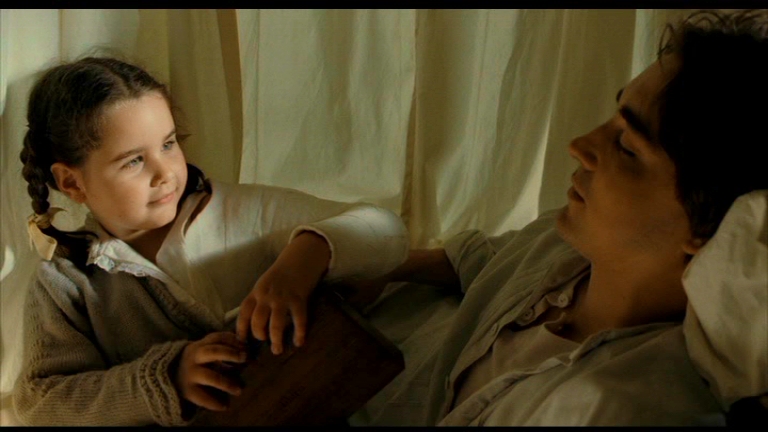
Film 2: Terry Gilliam had a more auspicious entry into the world of grandiose feature filmmaking than Tarsem. For those who don’t know, as the pivotal “secret” member of Monty Python, Gilliam – often mistakenly thought of as a Brit (he grew up in my frosty homeland of Minnesota) – created the sketch comedy series’ iconic animations. This positioned him to be the most qualified member of the troupe to direct their first feature film, Monty Python and the Holy Grail; Gilliam handled the photography, fellow Python Terry Jones handled the actors. This lead to Gilliam’s first solo project, the criminally underseen Jabberwocky. Then Gilliam’s short film The Crimson Permanent Assurance was included as the opening segment to Monty Python’s The Meaning of Life. So when Gilliam finally made his first major motion picture, Time Bandits, he was already a well-oiled machine. Then Gilliam dropped Brazil, which many consider his magnum opus. Following that, Gilliam did what most really interesting (and slightly crazy) artists do when flushed with the zenith of their success. He made something totally insane that was all but guaranteed to be a money-losing flop… The Adventures of Baron Munchausen.
Baron Munchausen was an actual dude, who lived in 18th-century Germany and took part in the Russo-Turkish War. Upon returning home from the war, the Baron supposedly became notorious for spinning far-fetched yarns about his adventures abroad. So famous did the Baron become that his stories spread across Europe (later the name Munchausen became synonymous with lying, getting immortalized as the psychological disorder Münchausen syndrome and the more disturbing Münchausen syndrome by proxy). In 1785, a collection of these stories was published in London by Rudolf Erich Raspe under the title Baron Munchhausen’s Narrative of his Marvellous Travels and Campaigns in Russia (the real Baron, who was still alive, was apparently not too happy with this). Raspe’s version of the Baron’s stories borrowed a lot from pre-existing legends, and over the years many have taken a stab at the Baron. So Gilliam was not adapting from a single source with his film; although he quite clearly modeled his Baron’s look after the book’s illustrations by the French artist Gustave Doré.
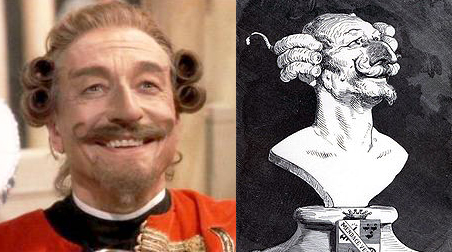
The film opens in a war torn, ambiguous late 18th-century Eurasian locale, accompanied by the very Pythonesque graphic: “Age of Reason. Wednesday.” A troupe of actors are presenting a stage version of the Munchausen legends to help entertain some citizens and injured soldiers. While the audience seems to be enjoying the show, the presentation bothers one spectator — an old man (John Neville) who claims to be the real Baron Munchausen. Of course, no one believes him, but the Baron says that this whole war was accidentally started by him a long, long time ago and promises that he can end the war if can find his old gang of super-powered cohorts: Berthold (fellow Python, Eric Idle), the world’s fastest man; Adolphus (co-screenwriter Charles McKeown), a rifleman with the world’s greatest eyesight; the dwarf Gustavus (Gilliam regular Jack Purvis; between the productions of George Lucas and Gilliam, the 80’s were a great time to be a British little person), who has the world’s greatest hearing and lung capacity; and Albrecht (Winston Dennis), the world’s strongest man. After sweet talking all the women in the theater into sewing a hot air balloon out of their knickers, the Baron sails off to find his entourage, only to discover he has a stowaway — Sally (Sarah Polley), the daughter of the theater troupe’s leader. Together Sally and the Baron journey into space, into a volcano, into the belly of a monstrous seabeast, and beyond.
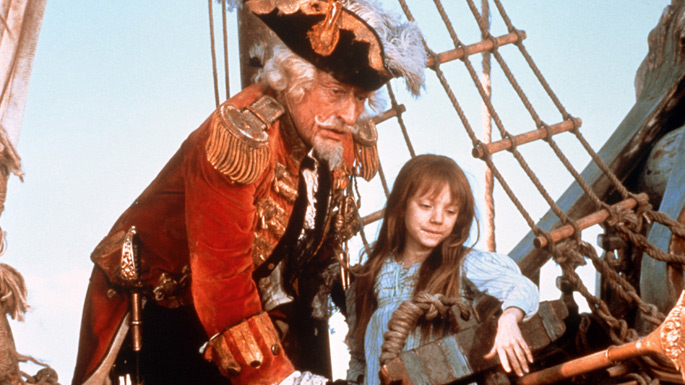
HERE BE SOME SPOILERS BELOW…
Double Feature Goggles: I love these films as a pair. They’re so similar, yet so very different. Their root contrast is how they approach the subject of storytelling. The Fall deals with the amorphous stream-of-consciousness storytelling one might find in a parent’s bedtime story or some children’s playground antics; the story evolves and changes as the teller(s) see fit, often improvising around realworld elements. Baron deals with the kind of classical and whimsical tall-tale storytelling found in books like Gulliver’s Travels. In both cases the young girls are our window into the stories. But Alexandria can directly effect The Fall‘s stories. Sally’s circumstance is a bit different – though at the end of the film it is revealed that the entire adventure was a story being told by the Baron from the theater’s stage (or what it?!), during the body of the film the Baron’s adventures are presented as truly happening. But Sally is nonetheless a mostly passive observer. She is effectively being told the story just as much as we are, despite her participation in the events. Both films also feature the Wizard of Oz-like device in which faces the little girls see in the real-world get re-used as characters within the fantasy world.
The Fall takes a very subtle and real approach to the idea of a grown man telling a story to a little girl, especially a foreign little girl. Words are said, but they aren’t necessarily received by Alexandria how they were intended by Roy. Here is where Tarsem shows that there is maybe a bit more to him than just cool visuals. Roy talks about the silent and brave “Indian” warrior. In the fantasy we’re shown a bearded Asian Indian, but as Roy keeps talking he uses words like “squaw” and “wigwam” and we realize that in Roy’s mind he’s talking about a Native American, but Roy and Alexandria never become aware that this discrepancy exists. Roy will also forget details, which Alexandria is quick to point out, and change characters midway through as he sees fit. Roy is God, and can do as he pleases. In Baron, where we’re living the story, the Baron doesn’t have the same level of power, but he still posses a storyteller’s control over certain elements and facts. Like Alexandria, Sally is often questioning the Baron’s logic (you can’t sail to the moon!), and the Baron is often proving her wrong — though he is proven wrong himself frequently too, as when he thinks they can extend the length of a rope they’re descending by cutting off the top and tying it to the bottom. Ultimately the difference between the two films is that The Fall is a story controlled by two people, whereas Baron is a story controlled by a single person.
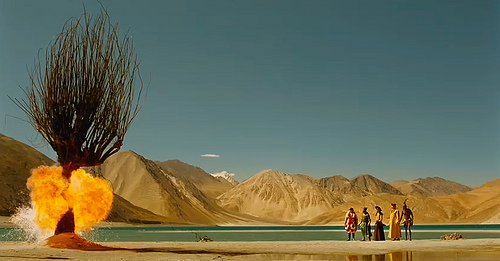
Tonally the films are very reflective of their respective filmmakers. The Fall, while playful in parts, is also overly dramatic, as one has to assume Tarsem is. Baron, like Gilliam, is cynical and satirical. Nothing in Baron is played truly seriously. The Fall has a few legitimately moving moments, like the fantastic scene in which Roy is having Alexandria touch his toes to see if he can feel anything, and the scene in which Roy is attempting suicide (morphine overdose) while telling Alexandria a story. The Fall also features one of the saddest animal deaths since Artax got sucked into that swamp in Neverending Story. But I don’t think a lack of emotional depth is a con for Baron, simply a different style. Baron is very funny in a very Gilliam sort of way — in the film’s opening sequence, the governmental official The Right Ordinary Horatio Jackson (the great Jonathan Pryce) is brought a soldier (Sting) who has just performed an astounding bit of bravery. Instead of giving the soldier a metal, Jackson condemns the man to death saying, “This sort of behavior is demoralizing for the ordinary soldiers and citizens who are trying to lead normal, simple, unexceptional lives.” Ah, what a British joke.
With these different tonal approaches come different character styles and performances. Lee Pace does a dandy enough job with Roy, but he simply can’t compare with John Neville’s exquisitely hammy performance of such a exquisitely hammy character. Neville plays the Baron in several different ages (the Baron gets younger when he has adventure in his life); it is the kind of role an actor is lucky to ever get in his/her life, and indeed Neville was mostly retired at the point Gilliam came along. The inverse is true of the young actresses. Sarah Polley is adorable and quite excellent as Sally, but she simply can’t compare with Catinca Untaru as Alexandria. For one thing, Alexandria is our protagonist here, and Tarsem cleverly staged his movie so that the vast majority of Alexandria’s performance is improvised. During the hospital section of the film, Tarsem shot everything sequentially and had Pace pretend to really be paralyzed to help authenticate Untaru’s performance (only once they got to the fantasy section did the girl learn Pace could actually walk). Thus Untaru isn’t really acting in the film. She’s just being a little foreign girl. Polley can’t compete with that.
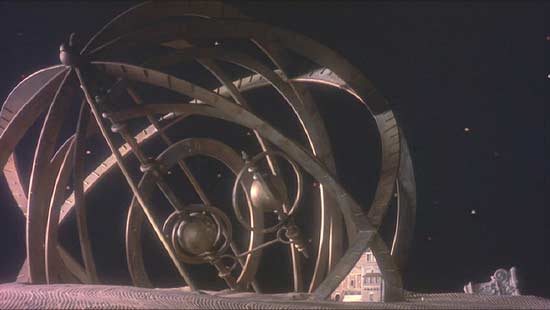
These respective approaches extend to our supporting characters too. The Masked Bandit’s gang feel a bit more two-dimensional than the Baron’s chums because they’re less relevant to Roy and Alexandria’s story. Indeed, they mostly seem to exist in the film for the moment when Roy kills them all off in a spell of drunken self-pity. The Baron’s gang are the impetus for his journey, and Eric Idle’s character in particular is a pretty meaty, fun role. (It’s also interesting in Baron – which feels very period appropriate and British – that the Baron’s entourage aren’t his friends, they’re his dutiful servants.) While Baron‘s super team can’t compete with The Fall‘s warriors in the visual department, Tarsem can’t really compete with Gilliam when it comes to fun. Berthold, Adolphus, Gustavus and Albrecht are incredibly fun, especially in there aged forms. I just love that Berthold has to wear huge prisoner-style leg irons so that he can walk at a normal speed, and that gigantic Albrecht wishes he were dainty. And of course, Baron has a wonderful array of bit players. Oliver Reed absolutely destroys his sequence with scenery chewing authority, as the bomb-building god Vulcan; married to Venus (an achingly hot 18-year-old Uma Thurman). Alas, the same can’t be said for Robin Williams as the King of the Moon, giving one of the most annoying performances of his career (which is saying something) and nearly ruining one of the film’s most imaginatively conceived sections. Other than that all our bit players are wonderful.
Speaking of imagination… here is the real appeal of both these films, of course. Performances, characters, story, blah blah blah. Both these films were box office failures, and both polarized critics and audiences alike. Both are admittedly a bit slow in parts, and their detractors screamed to high heaven about how “boring” they are. Yet people are still watching Baron and I think they’ll still be watching The Fall in twenty years too, because both films are monumental achievements in visual filmmaking. Simple as that. They look awesome. And that’s what will keep bringing people to them year after year.
The power of the visuals in both films comes from the fact that they are all real. The Fall utilized 100% real locations, which at certain times seems almost unbelievable that these places are truly standing somewhere – like the Chand Baori stepwall in Rajasthan; this Escher-looking place:
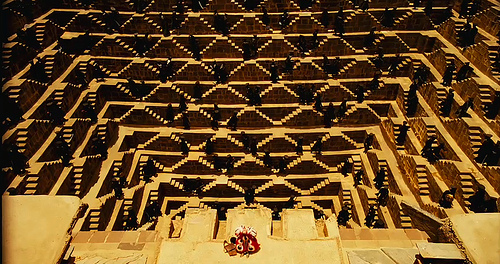
Baron, while utilizing nearly 100% artificial locations, was all pre-CG practical FX work, minatures and giant sets. At times it almost hurts your brain trying to figure out how they pulled certain shots off – such as the transitional shot of the Baron’s boat drifting on a starry sky that slowly turns into a sandy waste. The entire moon sequence is just phenomenal looking in both design and execution, as is the Sultan’s palace sequence (along with a harem of obese women). I love Gilliam’s use of intentionally quaint looking FX, such as those used in Berthold’s speed running, where he’ll cruise over hills in the distance leaving a cartoonish trail of smoke behind. Gilliam has a great eye for small yet memorable ideas, such as the Sultan’s executioner, who inexplicably has both his eyes sewn shut and thus needs to be positioned by another in order to chop the Baron’s head off (or just the fact that a dotted line is painted on the Baron’s neck, as though it were needed for aim). Or that the Earth, as seen from space, has longitude and latitude lines on it like a globe.
Both films haunt your eyes for days after viewing. Baron had the misfortune of going up against The Abyss for the Best Visual FX Oscar (hard to compete with that revolutionary water tentacle). But the fact that The Fall was not at least nominated for Best Costume Design is a testament to how poorly received The Fall was and how dumb the Oscars can be — the award that year went to The Dutchess; yawn *fart noise*. I guess we’ll see if people are still talking about the look of The Dutchess in twenty years. (Apologies, no actual offense meant to The Dutchess or its costumes.)
Previous Double Features
The Commitments/The Blues Brothers | The Set-Up/High Noon
The Plague Dogs/Secret of NIMH | The Old Dark House/Dolls
The Fury/Firestarter | Alligator/Q
Where the Buffalo Roam/Fear and Loathing in Las Vegas
Mad Love/Body Parts